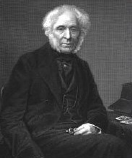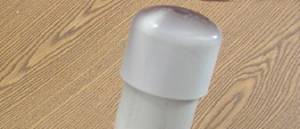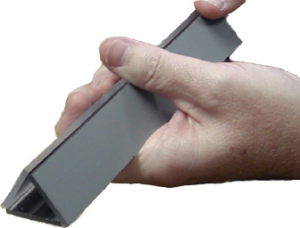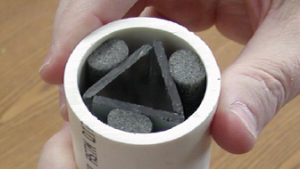The kaleidoscope
Short presentation of the project.
The project aims to study an instrument very often cataloged as a simple “toy”, but in reality, beyond the purely playful, unites itself a careful study of the phenomena of optics and a pleasant interest in science: just as wished to convey its inventor, Sir David Brewster, a scientist who had a philosophy to study while having fun, trying to appreciatethe pleasure that can come from scientific research without any speculative purposes. The kaleidoscope and then a tool rather interesting from many points of view, so that it used in the workplace by some web designers who are inspired by the colorful images produced by this tool to design the graphics of the sites. To fully understand the operation of the kaleidoscope is compulsary to have some knowledges in both mathematical and physical, without wich you can’t move to the second phase of the project involves the construction of a kaleidoscope, with the use of objects readily available from hardware.
Some biographical information on Sir David Brewster:
 David Brewster was born in Jedburgh , a small town in the Scottish lowlands , the ‘ December 11, 1781 . He immediately proved a child prodigy , building his first telescope to ten years. His natural inclination to scientific research and its innate intelligence led the family to entrust it to only twelve years at the University of Edinburgh , where he was soon appreciated and respected for his academic achievements , although the ‘ aim of his studies was of a theological , for he octene licensed to preach , Sir David Brewster soon abandoned his duties when , in 1799, a fellow student Henry Brougham persuaded him to study the diffraction of light , in the meantime, the results of his studies were published on the Philosophical Transaction , the scientific journal of the Royal Society of London. So in 1801 he devoted himself to the study of optics and the development of scientific instruments , working for twelve years in a series of experiments, the results of which were reported in the work A Treatise Upon New Philosophical Instruments , published in 1813. During these years he received several prestigious awards : in 1807 he was awarded the degree of Doctor of Law from the University of Aberdeen in 1808 and was proclaimed ” Fellow of the Royal Society of Edinburgh ,” but his fame as a scholar continue to grow dramatically so much so that he was named Fellow of the Royal Society of London in 1815 , and only one year after the Institute of France I assign a prize of three thousand francs for two important discoveries, including one on the polarization of light, which he had brought to fruition in the preceded the years . In that same year, his fame spread even among the non-scientific public , thanks to the discovery of the kaleidoscope ( the details of this invention were disclosed nelll’opera A treatise on the kaleidoscope of 1819 ), which had a great success among both the better-off is among the poorest in the UK. Despite the immediate success , Brewster got very few gains since its discovery due to an error in the grant of the patent . In fact, the main source of livelihood of the inventor were his writings, including those relating to the life of Isaac Newton and many others, including A Treatise on New Philosophical Instruments , A Treatise on Optics and a funny essay , popular in Paris around the goal of the ‘nineteenth century , entitled Nouveau manuel de magie naturelle et amusante , a ‘ work that is perfectly in line with the playful curiosity of many scientists of the time, it does not speak of occultism , as the title would suggest , but of machinery with the simple purpose of fun. Also contribute to expand the ‘ Encyclopedia Brittanica ( seventh and eighth ), writing entries on electricity , hydrodynamics , magnetism , optics and the stereoscope . Finally, I accept , in 1859, the office of chancellor of the University of Edinburgh, which he held until his death , February 10, 1868 .
David Brewster was born in Jedburgh , a small town in the Scottish lowlands , the ‘ December 11, 1781 . He immediately proved a child prodigy , building his first telescope to ten years. His natural inclination to scientific research and its innate intelligence led the family to entrust it to only twelve years at the University of Edinburgh , where he was soon appreciated and respected for his academic achievements , although the ‘ aim of his studies was of a theological , for he octene licensed to preach , Sir David Brewster soon abandoned his duties when , in 1799, a fellow student Henry Brougham persuaded him to study the diffraction of light , in the meantime, the results of his studies were published on the Philosophical Transaction , the scientific journal of the Royal Society of London. So in 1801 he devoted himself to the study of optics and the development of scientific instruments , working for twelve years in a series of experiments, the results of which were reported in the work A Treatise Upon New Philosophical Instruments , published in 1813. During these years he received several prestigious awards : in 1807 he was awarded the degree of Doctor of Law from the University of Aberdeen in 1808 and was proclaimed ” Fellow of the Royal Society of Edinburgh ,” but his fame as a scholar continue to grow dramatically so much so that he was named Fellow of the Royal Society of London in 1815 , and only one year after the Institute of France I assign a prize of three thousand francs for two important discoveries, including one on the polarization of light, which he had brought to fruition in the preceded the years . In that same year, his fame spread even among the non-scientific public , thanks to the discovery of the kaleidoscope ( the details of this invention were disclosed nelll’opera A treatise on the kaleidoscope of 1819 ), which had a great success among both the better-off is among the poorest in the UK. Despite the immediate success , Brewster got very few gains since its discovery due to an error in the grant of the patent . In fact, the main source of livelihood of the inventor were his writings, including those relating to the life of Isaac Newton and many others, including A Treatise on New Philosophical Instruments , A Treatise on Optics and a funny essay , popular in Paris around the goal of the ‘nineteenth century , entitled Nouveau manuel de magie naturelle et amusante , a ‘ work that is perfectly in line with the playful curiosity of many scientists of the time, it does not speak of occultism , as the title would suggest , but of machinery with the simple purpose of fun. Also contribute to expand the ‘ Encyclopedia Brittanica ( seventh and eighth ), writing entries on electricity , hydrodynamics , magnetism , optics and the stereoscope . Finally, I accept , in 1859, the office of chancellor of the University of Edinburgh, which he held until his death , February 10, 1868 .
General information about the kaleidoscope and how it works
The term kaleidoscope of Greek origin ( καλειδοσκοπεω ) and its significance in the Italian language can be so made , ” object that allows you to see beautiful forms .” The kaleidoscope and typically consists of a simple tube that may be of various materials ( cardboard, wood, plastic or metal) with inside a series of mirrors ( at least two ) places in the direction of length of the tube , in the front, separated by a round glass transparent , are inserted fragments of colored glass or plastic and in this same end there and a frosted glass that closes the tube . Supporting an eye on one end ( like a telescope ) and turning the ring (or the ‘ housing) present at the other end , you can see the symmetrical figures , formed from the more direct ones created by the reflections of the mirrors , which are typically present in a number of two or three ( although there are no particular kaleidoscopes with four mirrors arranged in a square or a rectangle) . Usually the number of mirrors used and three , which are arranged in an equilateral triangle , so as to form the following sequence of angles : 60 ° -60 ° -60 ° ( but in reality are two other possible combinations : 45 ° -45 ° -90 ° and 30 ° -60 ° -90 °) . There are also some variants of the kaleidoscope , which are listed below ( with l ‘ addition of key characteristics ) : – teleidoscope : no , front end , an envelope containing the 2 little parts colored , but a normal lens so that any object against which an image is focused can be turned into kaleidoscopic ; usually uses a system of three mirrors mounted to form an equilateral triangle , but can still use the other mirror systems ; – CellScope : at the front end there and a
, an envelope containing the 2 little parts colored , but a normal lens so that any object against which an image is focused can be turned into kaleidoscopic ; usually uses a system of three mirrors mounted to form an equilateral triangle , but can still use the other mirror systems ; – CellScope : at the front end there and a  “camera “, ie a cell 3contenente colored objects , it can be of various types : dry with completion objects are free to move or containing the liquid in which float numerous items . There is also a type of CellScope (built with special filters) that allows you to have an empty chamber , so that we can insert objects at will ;
“camera “, ie a cell 3contenente colored objects , it can be of various types : dry with completion objects are free to move or containing the liquid in which float numerous items . There is also a type of CellScope (built with special filters) that allows you to have an empty chamber , so that we can insert objects at will ;  – wheelscope : the front end can be one or more wheels of 4 Nature fixed or interchangeable and the wheels are different types of glass in shape and color combine to make the most imaginative reasons , there also a modern variant which has a capsule containing the liquid in which float many colored objects ; – marblescope : have a ball at the lower end 5 parts of the materials that can be more different , due to the
– wheelscope : the front end can be one or more wheels of 4 Nature fixed or interchangeable and the wheels are different types of glass in shape and color combine to make the most imaginative reasons , there also a modern variant which has a capsule containing the liquid in which float many colored objects ; – marblescope : have a ball at the lower end 5 parts of the materials that can be more different , due to the  repetitiveness of the images , this kind of kaleidoscope was not very successful , and can increase the complexity of the images by adding a second (or even third) ball .
repetitiveness of the images , this kind of kaleidoscope was not very successful , and can increase the complexity of the images by adding a second (or even third) ball .
Material needed to build a kaleidoscope
There are listed below the materials necessary for the construction of a simple kaleidoscope : – a PVC pipe (diameter 4-5 cm and length 17-18 cm) , of the type used for the hydraulic systems ; -3 strips of mirror same length of the tube ( the width of these must be such that , forming an equilateral triangle , they enter perfectly into the PVC pipe ) ; – an opaque cover , similar to the one in figure 6visibile , to cover one end of the tube (also element and readily available where they sell material for plumbers ) – strips of sponge or foam rubber adhesive (o-rings that sell to avoid the ‘ entry of air from the cracks of doors and windows) – a box of transparent plastic round of the same diameter or slightly higher than that of the tube of the kaleidoscope (for example, some packs of beads available in haberdashery or containers of cheese ) ; – sandpaper ; – adhesive tape; – glue ; – a drill and a drill bit 8 mm ( needed to pierce the front cover of the kaleidoscope ) ; – a dozen pieces of colored glass or plastic ( and can also use the beads of small size ) .
– an opaque cover , similar to the one in figure 6visibile , to cover one end of the tube (also element and readily available where they sell material for plumbers ) – strips of sponge or foam rubber adhesive (o-rings that sell to avoid the ‘ entry of air from the cracks of doors and windows) – a box of transparent plastic round of the same diameter or slightly higher than that of the tube of the kaleidoscope (for example, some packs of beads available in haberdashery or containers of cheese ) ; – sandpaper ; – adhesive tape; – glue ; – a drill and a drill bit 8 mm ( needed to pierce the front cover of the kaleidoscope ) ; – a dozen pieces of colored glass or plastic ( and can also use the beads of small size ) .
Instructions for installing the kaleidoscope
 Procure or crop three rectangular pieces of mirror, the length of which is equal to that of the PVC pipe (instead the width depends on the diameter of the tube ) and arrange them so as to form a triangle , passing around of the adhesive tape to attach them together. Naturally, the reflective part of the mirrors must be directed toward the inside . Finally insert the aforesaid mirrors in PVC tube of the kaleidoscope , fixing them in position with the aid of a few pieces of self-adhesive foam ( as visible in
Procure or crop three rectangular pieces of mirror, the length of which is equal to that of the PVC pipe (instead the width depends on the diameter of the tube ) and arrange them so as to form a triangle , passing around of the adhesive tape to attach them together. Naturally, the reflective part of the mirrors must be directed toward the inside . Finally insert the aforesaid mirrors in PVC tube of the kaleidoscope , fixing them in position with the aid of a few pieces of self-adhesive foam ( as visible in  the figure) . Drill a hole 8 mm in the center of the lid and place it on one of the ends of the PVC pipe . This hole and the opening will allow you to look inside the kaleidoscope. Rub the sandpaper on the plastic lid of the box round , so as to make it opaque SO light penetrates but you can not see objects that are located in front of the kaleidoscope. Glue the base of the box (the part that has not been sanded ) at the other end of the PVC pipe and put in small pieces of colored glass or plastic , finally closing it with a lid that has been sanded a little earlier.
the figure) . Drill a hole 8 mm in the center of the lid and place it on one of the ends of the PVC pipe . This hole and the opening will allow you to look inside the kaleidoscope. Rub the sandpaper on the plastic lid of the box round , so as to make it opaque SO light penetrates but you can not see objects that are located in front of the kaleidoscope. Glue the base of the box (the part that has not been sanded ) at the other end of the PVC pipe and put in small pieces of colored glass or plastic , finally closing it with a lid that has been sanded a little earlier.
Observations on the construction of the kaleidoscope and how it works
To build the kaleidoscope , and was necessary to establish the relationship that there was between the diameter of the tube, in which to insert the mirrors , and the width of the mirrors themselves. It was therefore studied the ratio of the equilateral triangle and the circle circumscribed to it , since it was decided to construct a kaleidoscope with a sequence of angles of 60 ° -60 ° -60 °, with the generic formula and the following : r = ab / 2h, where ” r” and the radius of the circumference (our tube ) , “a” and “b” are the sides of a scalene triangle generic and “h” and the height of the triangle ; this formula , of a general nature , this may be simplified to the case of the equilateral triangle , since the sides are all the same and the height can be expressed as √ 3/2 l, where “l” and the side of the equilateral triangle . Therefore the formula for the case of the equilateral triangle appears to be : r = l / √ 3 . Another way to obtain the measurement of the width of the mirrors and graphically , with the gauge measuring the diameter of the tube, and can be built on a sheet the equilateral triangle inscribed in the circumference , using a compass . This method is explained below : thanks to the measurements with the gauge, and you got the inside diameter of the pipe ( 45.90 } 0.02 mm ) and applying the formula shown above , and is obtained as a result l ~ 39.75 mm . However it was decided to cut the mirrors with a maximum width of 3.8 cm, so , being smaller than the diameter , were fixed with self-adhesive foam , which will land well still. Instead , for the length of the tube and of the mirrors , and is determined the extent of 20 cm . The reflection and an optical phenomenon that occurs when a light beam encounters a reflective surface , which reflects the following two laws listed below : – the incident ray , the reflected ray and the normal (ie, perpendicular ) to the reflective surface , the point of incidence , all belong to the same plane ; – the angle of incidence equals the angle of reflection . These laws are observed in the reflection on the flat mirrors , but the image reflected from the mirror and virtual , since e- symmetrically with respect to the actual image . If you have three of the kaleidoscope mirrors placed to form an equilateral triangle , so that the dihedral angles formed between them are the mirrors of 60 ° , and can obtain the number of reflected images using a particular formula , valid only for the dihedral angles of submultiples of 360 ° (360 ° / α ) – 1 where ” α ” and the dihedral angle taken into consideration. So going to replace in the formula the angle of 60 ° , is obtained as the number 5 , which corresponds to the number of virtual images generated , to which is added also the real one , then the number of symmetrical images reflected from our kaleidoscope and equal to 6 . As can be seen from this figure : Figure 10 shows only two mirrors, but the three-mirror system does not work very differently , since the only difference that the system creates a three-mirror reflection goes on and on , as shown in the image following.
thanks to the measurements with the gauge, and you got the inside diameter of the pipe ( 45.90 } 0.02 mm ) and applying the formula shown above , and is obtained as a result l ~ 39.75 mm . However it was decided to cut the mirrors with a maximum width of 3.8 cm, so , being smaller than the diameter , were fixed with self-adhesive foam , which will land well still. Instead , for the length of the tube and of the mirrors , and is determined the extent of 20 cm . The reflection and an optical phenomenon that occurs when a light beam encounters a reflective surface , which reflects the following two laws listed below : – the incident ray , the reflected ray and the normal (ie, perpendicular ) to the reflective surface , the point of incidence , all belong to the same plane ; – the angle of incidence equals the angle of reflection . These laws are observed in the reflection on the flat mirrors , but the image reflected from the mirror and virtual , since e- symmetrically with respect to the actual image . If you have three of the kaleidoscope mirrors placed to form an equilateral triangle , so that the dihedral angles formed between them are the mirrors of 60 ° , and can obtain the number of reflected images using a particular formula , valid only for the dihedral angles of submultiples of 360 ° (360 ° / α ) – 1 where ” α ” and the dihedral angle taken into consideration. So going to replace in the formula the angle of 60 ° , is obtained as the number 5 , which corresponds to the number of virtual images generated , to which is added also the real one , then the number of symmetrical images reflected from our kaleidoscope and equal to 6 . As can be seen from this figure : Figure 10 shows only two mirrors, but the three-mirror system does not work very differently , since the only difference that the system creates a three-mirror reflection goes on and on , as shown in the image following.  the figure shows only two mirrors, but the three-mirror system does not work very differently, since the only difference is that the three-mirror system creates a reflection goes on and on, as shown in the following image (which shows the combination 45 ° -45 ° -90 °)
the figure shows only two mirrors, but the three-mirror system does not work very differently, since the only difference is that the three-mirror system creates a reflection goes on and on, as shown in the following image (which shows the combination 45 ° -45 ° -90 °)


Leave a reply
You must be logged in to post a comment.